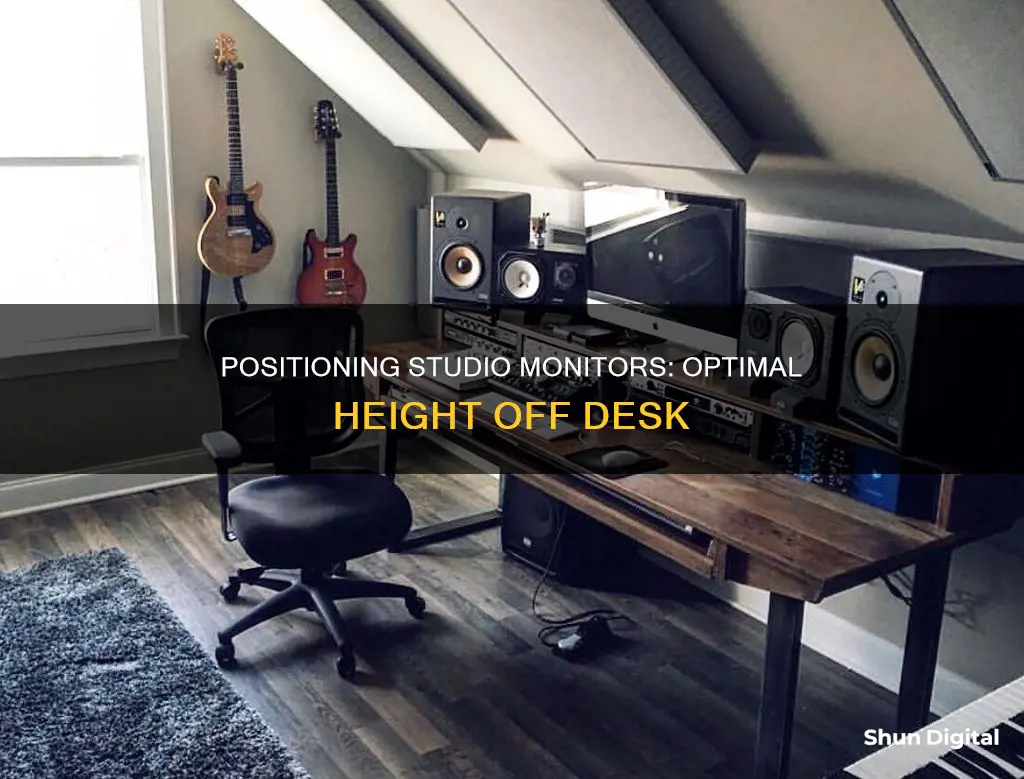
Studio monitor placement is critical to achieving optimal sound. The ideal height for studio monitors is typically between 47 and 55 inches from the floor, ensuring the tweeters are at ear level when seated. This standard height recommendation, however, is not set in stone and can vary depending on factors such as the type of monitors, the listener's position, and the room's acoustics. Let's dive into the key considerations for optimal monitor height and explore the impact of monitor placement on sound quality.
| Characteristics | Values |
|---|---|
| Ideal height | At ear level, typically 47-55 inches (120-140 cm) from the floor |
| Speaker placement | Form an equilateral triangle with the listener's head |
| Speaker angle | Pointed directly at the listener's head |
| Speaker height in relation to listener's head | Perpendicular axis |
| Speaker height in relation to room | Slightly above or below the mid-way point between the floor and ceiling |
| Speaker position in relation to rear wall | Closer than 0.5 m or more than 1.5 m away |
| Speaker position in relation to side walls | Maximise distance |
What You'll Learn
- Studio monitors should be at ear level
- Monitors should be slightly above or below the mid-point between the floor and ceiling
- The ideal distance between monitors and the side walls
- How to position monitors to avoid bass emphasis?
- The importance of monitor height in relation to the listener's head height

Studio monitors should be at ear level
Studio monitors should ideally be positioned at ear level, or slightly above or below, to achieve the best sound quality. This is because monitors are designed to be heard by a listener positioned on their perpendicular axis. The sound emanating from the speaker, known as horizontal and vertical dispersion, varies as you move from the front and centre of the speaker. Therefore, setting up so that you are facing the speakers at ear level ensures the most consistent and optimal sound.
If your desk or console is too low, you can use speaker stands to elevate the monitors. This is preferable to tilting the speakers, which can be precarious and cause them to topple over. By raising the speakers, you can also avoid early reflections from the desk's surface, which can interfere with the sound.
The distance between the speakers and your ears should also form an equilateral triangle, with the monitors turned inwards towards your head. This ensures a natural stereo "sweet spot", allowing you to move around slightly without compromising the sound quality.
Additionally, it is important to consider the distance of the monitors from the walls. Each boundary closer than 0.5m will have a noticeable bass-emphasizing effect. Therefore, it is recommended to position the monitors either closer than 0.5m to the rear wall or more than 1.5m away, with intermediate positions potentially causing frequency response errors.
V-Moda's Studio Monitors: Impressive Audio Performance
You may want to see also

Monitors should be slightly above or below the mid-point between the floor and ceiling
The height of your studio monitors is an important factor in achieving optimal sound quality. The general rule is to position the tweeters of your speakers at head height, usually about 47-55 inches (120-140 cm) from the floor, so that they are level with your ears. This ensures that you are in the near-field region and can hear the sound as it is intended, without the sound being muffled or distorted.
However, there are a few nuances to consider when adjusting the height of your monitors. Firstly, it is recommended that the height of the monitors be slightly above or below the mid-point between the floor and ceiling. This helps to minimise the impact of standing waves, which can distort the sound. By having the monitors at a different height to half the room's height, you can avoid soundwaves bouncing off surfaces and causing issues with your listening experience.
Another important consideration is the angle of the monitors. They should be angled slightly downwards towards your head so that the sound is directed at your ears. This is especially important if the monitors are positioned slightly above ear level, as you want to ensure the sound reaches your ears directly. Additionally, the monitors should be tilted at an angle that matches the other monitor, to balance out the bass, treble, and other music elements.
For near-field monitors designed for desk use, the height can be adjusted so that they are within a comfortable listening range, usually under two feet from the listener. This can be achieved by using monitor stands or desktop speaker stands, which also help to decouple the speakers from the desk surface and reduce early reflections.
Finally, it is worth noting that the height of the listener also plays a role in optimal sound quality. The listener's head should be positioned so that it forms an equilateral triangle with the two monitors, ensuring that the distance between the speakers is the same as the distance from each speaker to the ears. This setup provides a natural stereo "sweet spot" and allows for some movement without compromising the sound quality.
Understanding the ASUS ACPI Monitor Application
You may want to see also

The ideal distance between monitors and the side walls
The ideal distance between studio monitors and the side walls is dependent on a few factors. Firstly, the monitors should be placed at an equal distance from their respective side walls to ensure symmetry. This is crucial for accurate monitoring as different distances between the speakers and side walls will result in different frequency responses at the listening position, including two sets of nulls that cannot be fixed with software.
Secondly, the distance from the side walls should be maximised to reduce the reflection of midrange and high-frequency sounds from the monitors to the listener. A recommended minimum distance is 20 to 30 cm (8 to 12 inches) to reduce sound waves reflecting back to the listening position, and a maximum distance of 60 to 90 cm.
Thirdly, the distance from the side walls should be such that the distance from each side wall to the listening position is similar, and the acoustic reflection quality of the side walls is consistent. This helps to ensure a balanced stereo image.
Finally, it is important to consider the acoustic character of the environment around the monitors. For example, a monitor placed next to a large window will have a different acoustic character than one placed next to a bookshelf, potentially resulting in a skewed stereo image as reflections from the more reflective surface will dominate.
Does Your Monitor Have HDMI ARC?
You may want to see also

How to position monitors to avoid bass emphasis
The height of studio monitors is important for achieving optimal sound. Ideally, the tweeters should be at the same height as your ears when seated, typically about 47-55 inches (120-140 cm) from the floor.
If your studio monitors are placed on a desk, they will likely be well below ear height. In this case, you can either raise them or angle them so that their perpendicular axis points upwards towards your head.
To avoid bass emphasis, it is important to consider the distance of the monitors from the walls. Each boundary that is closer than about 0.5 m will have a noticeable bass-emphasizing effect. This is because monitors become more directional as frequency rises, so while bass sounds radiated backward or sideways will reflect off nearby walls and add to the direct sound, higher frequencies are not radiated backward or sideways to the same degree.
When monitors are positioned closer to walls, the level of bass will increase by 0-4 dB per wall, depending on the wall material (brick gives a bigger boost than gypsum). Corners, which have two walls, are especially good at boosting bass and should generally be avoided.
To compensate for boundary bass emphasis, many monitors incorporate low-frequency boundary EQ options. These settings should be configured appropriately—refer to the quick start guide or manual for your specific monitor model.
In general, it is recommended to position monitors either closer than about 0.5 m to a rear wall (with appropriate boundary EQ) or more than 1.5 m away from the wall. Intermediate positions can result in frequency response errors in the low-midrange frequency band due to rear wall reflections.
Additionally, maximizing the distance from side walls is usually beneficial. It is important to ensure that the distance from each side wall to the listening position is similar, creating symmetry between the left and right sides of your listening position.
Finding the Perfect Color Profile for Your Monitor
You may want to see also

The importance of monitor height in relation to the listener's head height
The height of studio monitors in relation to the listener's head is crucial to achieving optimal sound quality and accuracy. Here are some key points highlighting the importance of monitor height relative to the listener's head:
- Sound Clarity and Intention: Monitors are designed to be heard at ear level, ensuring the listener is positioned on their perpendicular axis. If the monitors are significantly above or below ear height, the sound will be altered, and the result may not translate accurately to other playback systems. This can lead to issues such as muffling or an unnatural stereo image.
- Avoiding Early Reflections: Placing monitors directly on a desk can cause early reflections, as sound bounces off the desk's surface and reaches the listener's ears before the direct sound from the monitors. By raising the monitors to ear height, you can reduce these early reflections and improve sound clarity.
- Stereo Imaging and Sweet Spot: The ideal monitor position forms an equilateral triangle with the listener's head, creating a natural stereo "sweet spot." This allows for slight head movements without compromising the stereo image. Ensuring the monitors are at ear height helps maintain this sweet spot and provides a consistent listening experience.
- High-Frequency Accuracy: High frequencies are more directional than lower frequencies. By positioning the monitors at ear height and angling them slightly downward, you ensure that the high frequencies are directed precisely at the listener's ears. This results in more accurate reproduction and perception of high frequencies.
- Consistency and Translation: Maintaining proper monitor height relative to the listener's head height helps ensure consistency in your mixes. It allows you to hear your music as it is intended, reducing the chances of ending up with a final product that sounds strange, grainy, or tinny. Proper monitor height increases the likelihood of your mixes translating well to other systems and environments.
- Flexibility and Adjustability: Raising the monitors to ear height provides flexibility in adjusting the angle and tilt. You can fine-tune the monitor position to ensure the sound is directed precisely at the listener's ears, optimizing the listening experience and minimizing the impact of room acoustics.
In summary, the importance of monitor height in relation to the listener's head height cannot be overstated. It ensures optimal sound quality, accuracy, and consistency. By positioning the monitors at ear level, you create the ideal conditions for critical listening, mixing, and producing music with confidence that your work will translate well across different playback systems and environments.
Kia Telluride EX: Blind Spot Collision Monitoring Feature?
You may want to see also
Frequently asked questions
The ideal height for studio monitors is to have the tweeters at the same height as the listener's ears when seated, which is typically about 47-55 inches (120-140 cm) from the floor.
It is recommended to position studio monitors symmetrically, forming an equilateral triangle with the listener's head, with the monitors angled slightly inward towards the listener. This ensures a balanced stereo image and helps to minimise room acoustics interference.
Positioning studio monitors correctly is crucial as it helps to ensure accurate sound reproduction and a solid stereo image. Incorrect placement can lead to peaks and valleys in the frequency response, resulting in a poorly balanced mix.
Yes, it is important to ensure that the monitors are not placed too close to walls or corners, as this can cause bass buildup and reflections that interfere with the sound. Additionally, the acoustic environment around the monitors, such as the levels of absorption and reflection, should be considered to create a symmetrical listening environment.







